
Pierre-Auguste Renoir was a French artist who was a leading painter in the development of the Impressionist style. As a celebrator of beauty and especially feminine sensuality, it has been said that "Renoir is the final representative of a tradition which runs directly from Rubens to Watteau."

Alfred Sisley was an Impressionist landscape painter who was born and spent most of his life in France, but retained British citizenship. He was the most consistent of the Impressionists in his dedication to painting landscape en plein air. He deviated into figure painting only rarely and, unlike Renoir and Pissarro, he found that Impressionism fulfilled his artistic needs.

Louveciennes is a commune in the Yvelines department in the Île-de-France region in north-central France. It is located in the western suburbs of Paris, between Versailles and Saint-Germain-en-Laye, and adjacent to Marly-le-Roi.

Bougival is a suburban commune in the Yvelines department in the Île-de-France region in Northern France. It is located 15.3 km (9.5 mi) west from the centre of Paris, on the left bank of the River Seine, on the departmental border with Hauts-de-Seine. In 2019, Bougival had a population of 8,790.
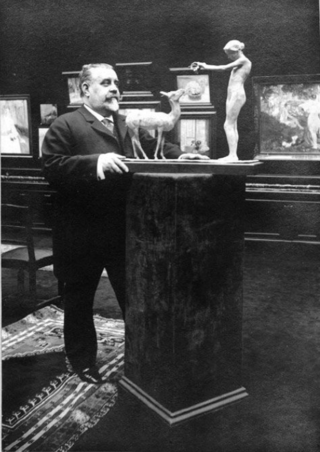
Georges Petit was a French art dealer, a key figure in the Paris art world and an important promoter and cultivator of Impressionist artists.

The Terrace at Saint-Germain, Spring is a painting by English Impressionist painter Alfred Sisley, completed in 1875. It is in The Walters Art Museum collection.

Albert Lebourg, birth name Albert-Marie Lebourg, also called Albert-Charles Lebourg and Charles Albert Lebourg, was a French Impressionist and Post-Impressionist landscape painter of the Rouen School. Member of the Société des Artistes Français, he actively worked in a luminous Impressionist style, creating more than 2,000 landscapes during his lifetime. The artist was represented by Galerie Mancini in Paris in 1896, in 1899 and 1910 by : Galerie Bernheim-Jeune, 1903 and 1906 at the Galerie Paul Rosenberg, and 1918 and 1923 at Galerie Georges Petit.
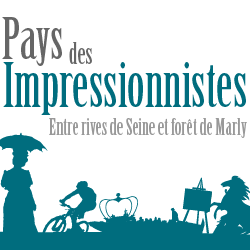
The Pays des Impressionnistes is a certification mark created by the Syndicat intercommunal à vocations multiples des Coteaux de Seine in 2001 to promote the cultural heritage of this touristic area. Nine municipalities in the Yvelines department of France bordering the loop of the Seine River, where, during the nineteenth century, impressionist painters exercised their art, are associated with this creation: Bougival, Carrières-sur-Seine, Chatou, Croissy-sur-Seine, Le Pecq, Le Port-Marly, Louveciennes, Marly-le-Roi and Noisy-le-Roi. There is the Path of the Impressionists, four hiking trails dotted with reproductions of paintings, reflecting the still remarkable character of this landscape of Impressionist sites which has been proposed for inclusion in the World Heritage Site since 2009. Rueil-Malmaison, in the Hauts-de-Seine department, joined them in 2010, when eight of these municipalities have entrusted development task of the Pays des Impressionnistes to the visitor center of Marly-le-Roi, which organises Impressionist cruises along the banks of the Seine, as well as visits of ateliers of contemporary painters.

Dance at Bougival is an 1883 oil-on-canvas painting by the French artist Pierre-Auguste Renoir, currently in the collection of the Museum of Fine Arts in Boston, Massachusetts, USA. Described as "one of the museum's most beloved works", it is one of three in a collection commissioned by Paul Durand-Ruel. It depicts a scene in the French village of Bougival, about 15 km from the center of Paris, a site utilized by many Impressionists besides Renoir including Claude Monet, Alfred Sisley, and Berthe Morisot.

Moïse Lévy de Benzion (1873–1943) was an Egyptian department store owner who built an important collection of art and antiquities. The collection was plundered by the Nazis in France during the Second World War and nearly 1000 items seized.
Janice H. Levin (1913–2001) was an American businesswoman and philanthropist and art collector from New York City. She was a patron of the ballet and collected mostly French impressionist paintings. She was a supporter of higher education as well as charities in Israel. She donated many of her paintings to museums.
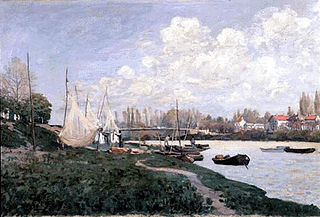
Drying Nets or Fishermen Spreading Their Nets is an 1872 oil-on-canvas painting by Alfred Sisley, now in the Kimbell Art Museum. The painting shows a scene near the village of Villeneuve-la-Garenne.

The Seine at Port-Marly, Piles of Sand is an 1875 painting by Alfred Sisley. It was exhibited at the Exposition Universelle in 1900 whilst in the collection of Dr. Georges Viau, a Paris dentist and art collector. By 4 March 1907 it was owned by Durand-Ruel, who tried and failed to auction it on 4 March that year. It was bought by the galerie Bernheim-Jeune in April 1920 and later by Martin A. Ryerson. In 1933 Ryerson left it to its present owner, the Art Institute of Chicago, where it is now in section 201 (Impressionists) on the 1st floor of the Art Institute of Chicago.

Ferry to the Ile-de-la-Loge – Flood is a painting by Alfred Sisley. He produced it during a flood on the Seine, which had begun in late October and reached its peak on 17 December. The painting was finished in December 1872. It was bought for 200 francs by Durand-Ruel on 21 January 1873 and exhibited at the First Impressionist Exhibition in April 1874 as number 162 It was later owned by François Depeaux before forming part of the Depeaux sale at the Georges Petit gallery in Paris on 31 May 1906. It was acquired by the Carlsberg Foundation in 1914 and later that year it was exhibited at the Statens Museum for Kunst before being acquired later the same year by its present owner, the Ny Carlsberg Glyptotek in Copenhagen.
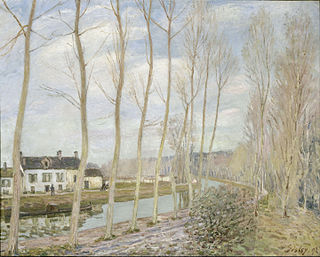
The Canal du Loing or The Canal du Loing at Moret is an 1892 painting by Alfred Sisley, donated to the Musée du Luxembourg after the painter's death in 1899 by a group of the painter's friends headed by Claude Monet. It is now in the Musée d'Orsay. A similar work, painted in winter 1891, is now in the National Museum of Fine Arts of Algiers.

Villeneuve-la-Garenne, Village Beside the Seine or Village on the Seine is an 1872 oil-on-canvas painting by Alfred Sisley, now in the Hermitage Museum in St Petersburg.
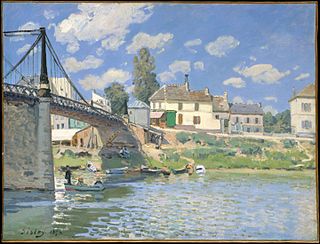
The Bridge at Villeneuve-la-Garenne is an oil on canvas painting by Alfred Sisley created in 1872.

The Moret Church series of some dozen oil paintings was executed in 1893/94 by the English Impressionist artist Alfred Sisley. The church building depicted in each of the paintings is the Church of Notre-Dame in the village of Moret-sur-Loing, Seine-et-Marne, France, where Sisley had elected to see out his days until his death in 1899.

A Couple also known as The Engaged Couple or Alfred Sisley and his Wife, is an oil-on-canvas painting by the French artist Pierre-Auguste Renoir (1841–1919), created around 1868 during his early Salon period at a time when he focused on thematic works about couples. It was acquired by the Wallraf–Richartz Museum in 1912.


















